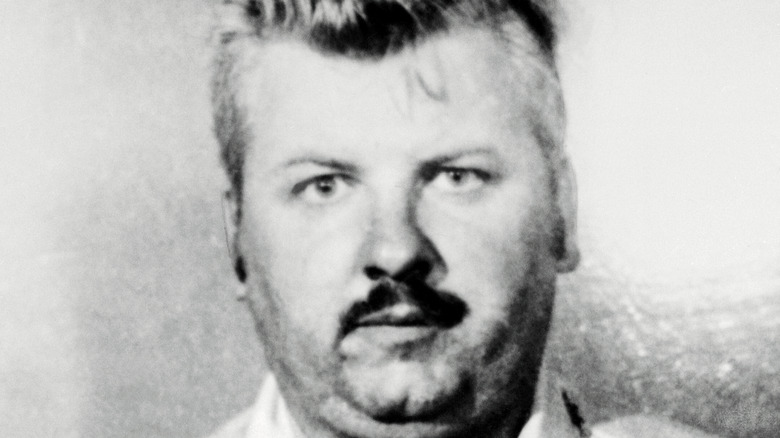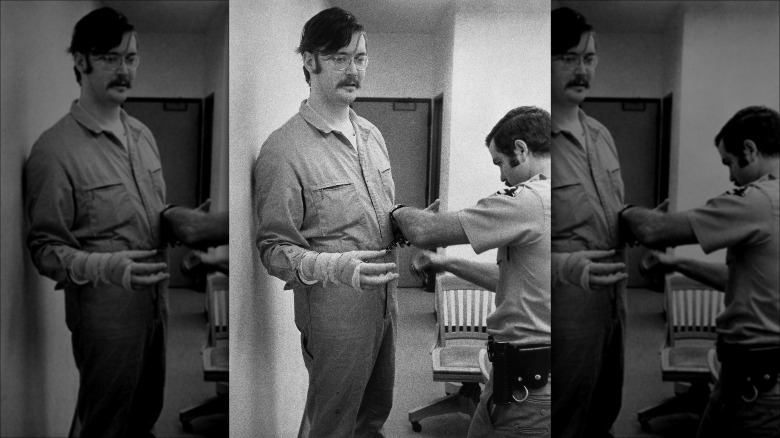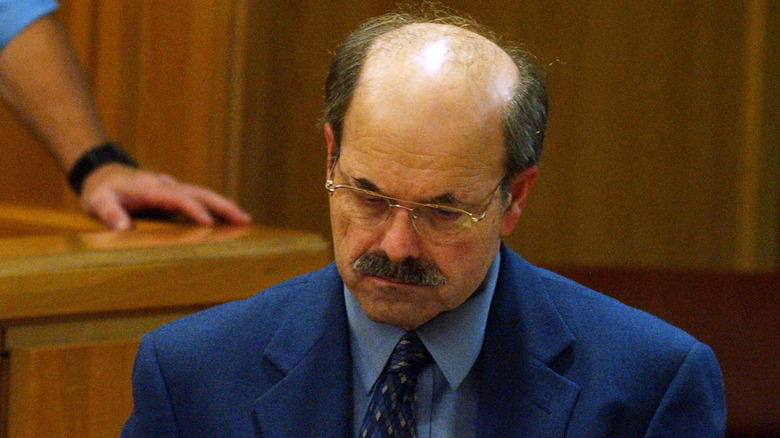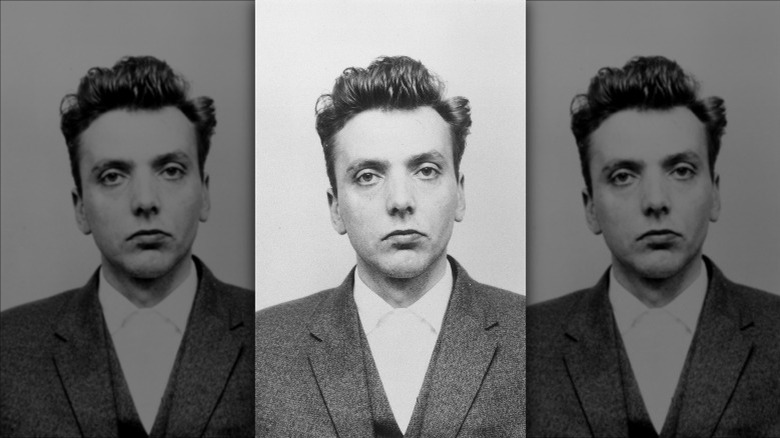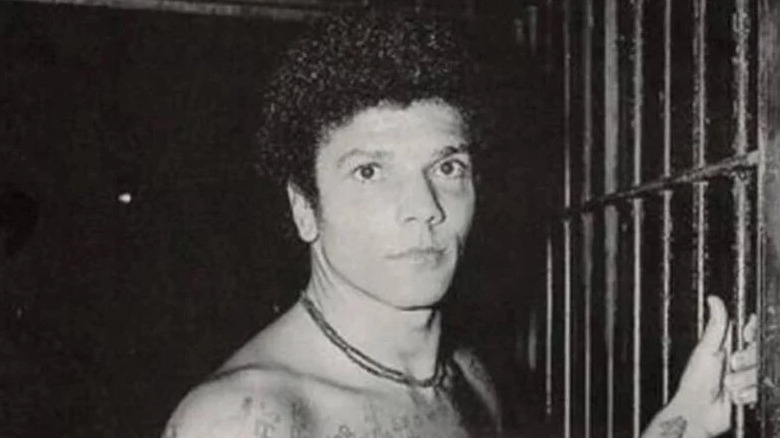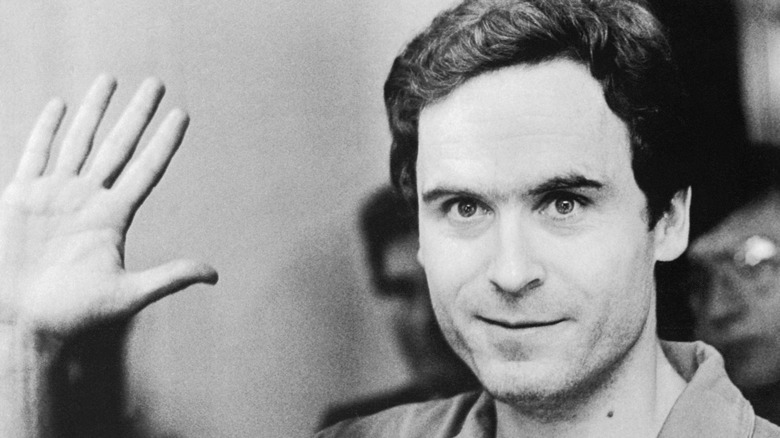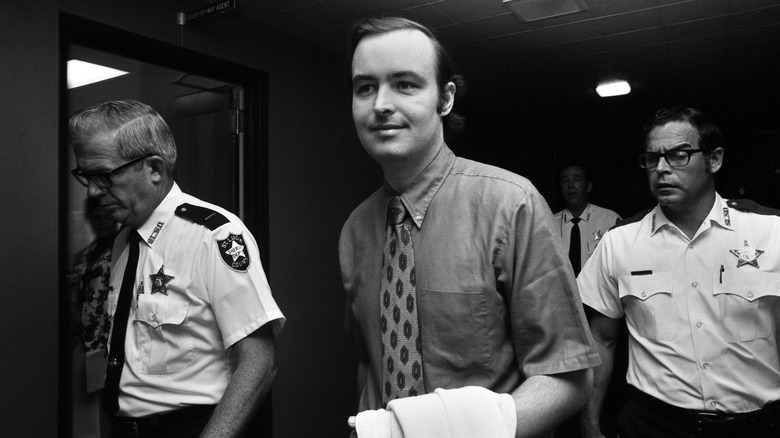Serial Killers Who Couldn't Stand Each Other
Serial killers are rarely famous for their opinions. However, high-profile murderers attract a specific type of celebrity intrigue, and the types of people who want to know the grisly details of various crimes often wonder how the alleged perpetrator might think. The FBI has warned about the potential dangers of media talking heads, but there is a tremendous cottage industry of experts and pseudo-experts ready to fulfill an audience's endless interest in convicted killers — including documenting their opinions on other convicted murderers.
Once serial killers land in custody, a world of reporters, writers, and interested professionals tend to record their stories. Some of these media voices manage to speak to killers directly, and their barrage of questions sometimes touches a raw nerve. In other cases, perpetrators are so excited to talk that they put their opinions out there on their own. No two serial killers are identical, but they often share some commonalities. To no one's surprise, a lot of serial killers have wildly negative opinions about their fellow convicted murderers.
Content warning: The following article contains mentions of suicide, sexual assault, and child murder.
John Wayne Gacy hated Jeffrey Dahmer
John Wayne Gacy confessed to approximately 30 murders in 1978, six years after he committed his first known murder. After Gacy confessed, authorities found 29 bodies on his property and four in nearby rivers. Two years before his 1994 execution, Gacy spoke to CBS 2's Walter Jacobson. While speaking to Jacobson for more than two and a half hours, Gacy vociferously denied the crimes to which he had previously confessed. Gacy recontextualized his confessions, denying all of the previous statements he had made to police and investigators. He bristled at any connection Jacobson made to the 33 murders of which he'd been convicted.
One of the most heated moments in Jacobson's interview involves bringing up other killers. Jacobson mentioned names like David Berkowitz and Ted Bundy, but Gacy pushed back against any comparisons. Gacy told Jacobson, "God, I hate that, when they put me in the same club with them."
He reserved slightly more nuanced commentary for Jeffrey Dahmer. By the time Gacy's interview aired, Dahmer had received 16 life sentences. When Jacobson asked the Killer Clown what he thought of Dahmer, Gacy chose to discuss the fact that Dahmer was not declared insane during his trial. Gacy strongly believed that Dahmer's case represented a failure of the justice system. He stated, "If Jeffrey Dahmer doesn't meet the requirements for insanity, then I'd hate like hell to run into the guy that does."
Edmund Kemper despised Herbert Mullin
Ed Kemper lives in the California Medical Facility in Vacaville, where he will most likely die. Kemper has been incarcerated on eight counts of homicide since 1973. He killed his grandparents in 1964 when he was 15 years old, then carried out a string of murders in 1972 and 1973. Kemper's extended stay provided countless opportunities to collect interesting stories, and he attracted public attention by speaking to a pair of profilers from the FBI.
The November 1, 1973, issue of the Santa Cruz Sentinel covered a portion of the Co-ed Killer's trial. Of specific note, staff writer Tom Honig recounted an exchange between Kemper and the district attorney. The DA asked Kemper why he'd thrown water on the man in the cell beside him during his stay at the San Mateo County Jail. Kemper discussed his bizarre relationship with Herbert William Mullin. Mullin killed 13 people in California, his killing spree overlapping with Kemper's. Kemper was very candid about his feelings toward Mullin. He described throwing water on Mullin to "shut him up." Kemper considered Mullin a nuisance, but he developed a system to solve that problem. Kemper rewarded Mullin's silence with peanuts, positively conditioning him to be a model inmate. This strange arrangement led Kemper to call Mullin "mentally ill." Mullin passed away in 2022, but Kemper was still serving his sentence as of 2024.
Randy Steven Kraft and William Bonin loathed each other
According to Vanity Fair, in 1990, four convicted serial killers met every day for a game of bridge on San Quentin State Prison's death row. The players were Randy Steven Kraft, William Bonin, Doug Clark, and Lawrence Bittaker. Kraft was the Scorecard Killer who remains in San Quentin after the police found a coded list of his alleged kills in 1983. Bonin was the Freeway Killer, a nickname he shared with Kraft. Clark, along with an accomplice, was the Sunset Strip Killer who targeted sex workers in Los Angeles. Bittaker was one of the two Tool Box Killers who kidnapped, tortured, and murdered five girls in 1979.
San Francisco-based writer Mark MacNamara observed and interviewed the four killers about their daily game. To hear him tell it, Kraft and Bonin never got along. MacNamara described the breakdown of each game: Bridge requires two teams of two, so Kraft played with Clark while Bonin partnered with Bittaker. MacNamara off-handedly mentioned that Kraft and Bonin "loathe each other and refuse to play together." This kept them from playing on the same side, but they still joined in card games every day. The relationships on San Quentin's death row seem quite complex, but apparently there's still plenty of room for hate.
Israel Keyes thought BTK was a wimp
Wichita police arrested Dennis Rader and charged him with 10 counts of first-degree murder in 2005. Rader was in hiding for more than 25 years before his arrest. Under his self-appointed nickname, BTK, Rader killed at least 10 people between 1974 and 1991. In the lead-up to the trial, multiple news sources issued shaky reports that implied confessions from Rader. Rader initially refused to speak at his arraignment, but he became more talkative at his trail. Rader confessed his crimes in vivid detail but offered no apology or contrition. A few weeks later, he expressed his faith and remorse after several statements from his victims' families. This rambling expression of guilt earned him some condemnation from Israel Keyes.
Keyes robbed banks, burglarized homes, and killed at least three people. He was obsessed with serial killers, specifically idolizing Ted Bundy. The Anchorage Daily News reports an interview Frank Russo conducted with Keyes. Russo, the assistant U.S. attorney for Alaska, chatted with Keyes shortly before his death by suicide in 2012. He mentioned Keyes' appreciation for Bundy and his feelings on BTK. Russo believed Keyes saw Rader as a wimp for apologizing to his victims' families. This seemed to be a consistent belief of Keyes, who also stated that his favorite serial killers were those who were still on the loose.
Ian Brady wrote a book on serial killers
Ian Brady and his partner, Myra Hindley, committed the so-called Moors murders in and around Manchester, England. They killed five children between 1963 and 1965. Brady spent 19 years in prison before his failing health got him hospitalized under the Mental Health Act. He spent the rest of his life at Ashworth Psychiatric Hospital, where he routinely requested death. During his time at Ashworth, Brady wrote "The Gates of Janus," a book about the psychology of serial killers. Each chapter covers a specific killer, many of whom he exhibits strong opinions on. One of his strangest takes involves Ted Bundy.
Brady described Bundy's character in detail. His language shifts between hagiographical praise and damning criticism. Brady considered Bundy a very competent liar. In "Gates of Janus," he repeatedly compares Bundy to a politician. He specifically notes that Bundy should have been a public servant who used his position of power to fleece his constituents. There are elements of Brady's text that read like he's applauding Bundy, but his prolonged description of the notorious American killer as an accomplished deceiver also seems like a withering critique. He's certainly less kind to Bundy than he is to many of his other subjects.
Ian Brady and and Raymond Morris repeatedly attacked each other
Raymond Morris killed three children in Staffordshire, England, between 1965 and 1968. His activities became known as the Cannock Chase murders. Morris was convicted on one murder charge and was widely believed to be responsible for the other two. He started his life sentence at HM Prison Durham in 1969, just over three years after convicted child murderer Ian Brady arrived at the facility. The two killers, both among the nation's most notorious, met in prison and fought a couple of unusual battles.
Birmingham Live reports from an unearthed news clipping that unpacks Brady and Morris' rivalry. In two incidents, the men attacked each other with hot liquids. The paper suggests that Brady struck first. He poured hot tea on Morris, evidently selecting his concoction to deal damage. He brought his tea to a boil and added sugar, ensuring that the scalding liquid would stick to Morris' head. This landed Brady in solitary confinement for 28 days. Morris later retaliated, pouring hot water over Brady. He received the same sentence. Birmingham Live also notes Sunday Mercury historian Richard Pursehouse, who believed that the fight broke out over which of the two killers was more notorious.
Kanae Kijima and Miyuki Ueta traded insults
Miyuki Ueta and Kanae Kijima were sentenced to death for very similar crimes. Kijima was the Konkatsu Killer, who enticed several men, stole their money, and poisoned them. She was convicted of three murders and suspected of four others. Ueta also robbed and killed at least two men, with four other potential victims in her background. Both women committed their crimes in the 2000s and received death sentences in 2012. They were confined in different prisons, and there's no notable report of them meeting, but they did trade verbal barbs in the press.
Most of the details of Kijima's opinions come from the blog she maintained while she was incarcerated. The blog is still up, but it is in Japanese, forcing non-speakers to rely on translation software. Kijima mentioned her jealousy after writer Osamu Aoki covered the story of Ueta. Kijima appeared infatuated with Aoki, who wrote the 2013 book "Two Consecutive Cases of Suspicious Deaths." That jealousy pushed her to sling insults. The Rotten Mango podcast reports Kijima repeatedly calling Ueta an idiot while celebrating Aoki's genius. The podcast's translation of Ueta's press interviews suggests that she'd cut reporters out of her life for mentioning Kijima. This bizarre feud never amounted to much, but their shared hatred seemed very sincere — at least until Ueta reportedly choked to death in her cell in 2023.
Tsutomu Miyazaki couldn't stand Kaoru Kobayashi
Tsutomu Miyazaki became known as the Otaku Murderer and the Human Dracula, one of Japan's most feared serial killers, in the early 1990s. Miyazaki kidnapped and killed four young girls in 1988 and 1989. He expressed bizarre ideology while on trial, even blaming his actions on an alter ego called the Rat Man. Miyazaki caused some public uproar when his interest in anime, manga, and several other elements of pop culture esoterica came to light. Elements of moral panic claimed Japan after Miyazaki went to prison, making him one of the most impactful killers in Japanese history.
His work inspired at least one devotee. Kaoru Kobayashi kidnapped and assaulted at least eight children. He killed at least one and tried to kill another. In statements during his trial, he declared himself "the second Miyazaki." In The Daily Yomiuri Online, the writer cites both Kobayashi's statements and Miyazaki's response. In his book, Miyazaki stated, "I won't allow him to call himself 'the second Tsutomu Miyazaki' when he hasn't even undergone a psychiatric examination." Miyazaki expressed an obsession with such tests, but his fascination with Kobayashi was much more limited. He rejected Kobayashi's attempt to compare them, changing the subject almost immediately.
Joanna Dennehy supposedly threatened Rose West
Rose West collaborated with her husband, Fred, to torture and murder at least nine women. Fred died by suicide before his trial, but Rose received a life sentence in 1995. In 2008, threats from other inmates prompted authorities to move her from her original jail to HM Prison Low Newton in Durham, England, according to International Business Times UK. The IBT also reports an attack several years after the move by a younger prisoner at Low Newton. West evidently experienced several negative interactions with fellow prisoners at the facility, including threats allegedly made by another serial killer, that may have forced authorities to move her yet again.
In 2019, rumors began circulating in the media that Joanna Christine Dennehy, who stabbed three men to death in 2013, had threatened Rose West's life. The U.K. tabloid the Mirror claimed that Dennehy had threatened to kill West upon her transfer to Low Newton. The tabloid reports that Dennehy made several threats against West, but none of the listed examples include any specific motivation. Dennehy did not get the chance to make good on those threats, as West was reportedly transferred to another facility the day Dennehy arrived at Low Newton. Citing "insiders" at the prison, the Mirror claimed that West was devastated to leave. It should be noted that the tabloid report is based entirely on unnamed sources, and the incident has not been confirmed by any other outlet.
Pedro Rodrigues Filho wanted to kill Francisco de Assis Pereira
Pedro Rodrigues Filho, also known as Killer Petey, was a vigilante serial killer who may have inspired "Dexter." His story feels pulled from a comic book. Rodrigues started his career by robbing and killing drug dealers, gaining notoriety across Sao Paulo, Brazil. He reportedly lost his pregnant girlfriend to gang violence, sparking an escalation in his campaign of violence. Rodrigues was convicted of killing 71 people, all of them supposedly criminals, though many believe he killed over 100 people. He was 14 when he started and 18 when he got arrested. Rodrigues killed several fellow prisoners, consistently elongating his sentence.
One of his potential targets escaped his grasp. Francisco de Assis Pereira, also known as the Park Maniac, received a sentence of 268 years imprisonment after raping and murdering 11 women and assaulting nine others. Aventuras Na Historia reports Rodrigues' desire to kill the Park Maniac. Rodrigues expressed his disgust toward Pereira to reporter Marcelo Rezende. Pereira apparently drew Rodrigues' hatred immediately. Rodrigues detailed their first encounter, suggesting that he'd be dissatisfied to leave jail without having killed Pereira, though nothing ever came of it.
Ted Bundy didn't care for the Green River Killer
One of the most common threads in serial killer fiction depicts an incarcerated killer using their insider knowledge to help law enforcement capture a new threat. This flawed premise has several origin stories, but Ted Bundy's efforts to help catch the Green River Killer might be the most interesting. Robert Theodore Bundy received three death sentences throughout 1979 and 1980. Bundy confessed nine years later. Four years into his death row stint, he reached out to investigator Robert Keppel and offered his help as an expert investigator in the Green River Killer case.
Keppel wrote "The Riverman: Ted Bundy and I Hunt the Green River Killer" in 1995. The book features a lot of interesting insights into Bundy's mind. Keppel regularly prompted Bundy to provide assistance by praising him. This led to a fair amount of negative chatter about the so-called Riverman. In 2003, Sheriff Dave Reichert spoke to The New York Times about his experiences with Bundy. He hypothesized that Bundy felt some jealousy toward the Gary Ridgway. This combination of superiority and envy suggests a strong dislike for the Green River Killer.
Gerard Schaefer didn't think much of Ted Bundy
Killers often express a sense of superiority over other killers. For example, Gerard Schaefer thought little of Ted Bundy. Schaefer was convicted of killing two young women, though he may have had as many as 30 victims. The real window into Schaefer's mind comes through Sondra London, who dated Schaefer in high school and reconnected with him after his conviction. She became a true crime journalist in the meantime. Shortly after Schaefer's death in prison, London wrote an extended online post about her experience with him.
Schaefer apparently talked about Bundy all the time. London recounts several long-winded brags that mark Bundy as Schaefer's perceived rival, with Schaefer applauding himself for exceeding Bundy's victim count. He also suggested that he kept Bundy spellbound in a conversation about their habits. Schaefer even had the gall to suggest that Bundy was mimicking him. London quoted him as saying, "He was playing at copycat and doing a poor job of it at that."
It wasn't just London who was subjected to Schaefer's thoughts on Bundy. In a 2008 French documentary, Schaefer shared an anecdote about manipulating Bundy by reveling in his crimes.
Danny Rolling and Gerard Schaefer fought over a woman
Sondra London became romantically involved with multiple serial killers, including Danny Rolling, also known as the Gainesville Ripper. He confessed to eight murders, but the state of Florida gave him the death penalty for five. While awaiting his execution, Rolling met Sondra London. They were engaged at one point. The bizarre circumstance opened the door for Rolling and fellow killer Gerard Schaefer to express exactly how they felt about each other.
In London's "Killer Fiction: Stories That Convicted the Ex-Cop of Murder," Schaefer hurled several insults at Rolling. Schaefer co-wrote the book through letters to London, calling Rolling a coward in an unhinged screed. He objects to the idea of his writing benefiting Rolling in any way. As if to counter him, the back of the book features quotes from killers, including Rolling. Rolling considered the book "well-written puke." This back-and-forth went on until Schaefer died in prison. Rolling and Schaefer were both incarcerated at Florida State Prison. In a letter to London, Rolling suggested that Schaefer was in danger. He was quickly proven right — Schaefer was stabbed to death by another inmate in December 1995. Rolling and Schaefer seemed to hate each other with or without London, but she really drew their opinions into the open.
[Featured image by Bob Chappell/Errol Morris' Production Company via Wikimedia Commons | Cropped and scaled | CC BY 3.0]
If you or someone you know is struggling or in crisis, help is available. Call or text 988 or chat 988lifeline.org

